The 2025 CSGO Major Qualifiers represent a significant shift in the landscape of global esports. Rather than maintaining a standard, uniform approach, Valve has implemented region-specific qualification systems that recognize distinct competitive qualities. In doing so, the structure not only maintains space for the dominant organizations but also creates accessible pathways for emerging teams around the world. The result: a more competitive, globally inclusive tournament.
Summary
CSGO Major 2025 Qualifiers – Direct Qualifiers

Direct qualification now relies on Valve Regional Standings—essentially, a comprehensive ranking based on months of sustained success rather than isolated tournament victories. This approach precludes teams from gaining entry via singular upsets or “hot streaks” and rewards only those organizations which demonstrate long-lasting excellence. Teams such as NAVI, Vitality, Spirit, and G2 exemplify the persistence and consistency needed to secure direct qualification, reinforcing the principle that genuine competitive merit is cumulative.
CSGO Major 2025 Qualifiers – European MRQ

Europe’s Major Qualifier employs a Swiss-System format, which dynamically matches teams based on current performance instead of rigid brackets. This formulation allows competitors to recover from initial losses, provided they adapt their strategies and improve execution in subsequent matches. For example, B8 and Nemiga displayed notable resilience, ultimately securing crucial victories after early set-backs.
Americas MRQ: Redemption Encapsulated in Double-Elimination


In the Americas, Major Qualification proceeds through a double-elimination structure. This format demands resilience and a capacity to withstand adversity; teams relegated to the lower bracket face multiple elimination matches with their tournaments on the line. Notably, squads such as NRG and BESTIA demonstrated significant mental fortitude, recovering from setbacks to emerge as legitimate contenders. The system thereby highlights psychological resilience as an essential aspect of competitive success.
Asia-Pacific MRQ: Growth and Regional Diversity



—Picture source from internet—
For the Asia-Pacific qualifier, Valve introduced explicit regional subdivisions—incorporating China, Mongolia & West Asia, and Oceania & Southeast Asia. This organizational design guarantees broad representation, affording both established and developing competitive scenes exposure at the highest level. Teams such as TYLOO (China), FlyQuest (Oceania & Southeast Asia), and Chinggis Warriors (Mongolia & West Asia) illustrate this diversity. Ultimately, these sub-regional qualifiers accelerate growth and reinforce the global reach of the competitive Counter-Strike ecosystem.
Conclusion
The 2025 CSGO Major Qualifiers reflect a deliberate and structured effort to balance consistency, adaptability, and inclusivity on a global scale. The Regional Standings reward sustained excellence, the European Swiss-System evaluates resilience, the Americas double-elimination emphasizes endurance, and the Asia-Pacific framework promotes diversity. Collectively, these formats constitute the most comprehensive and challenging qualification process in Counter-Strike history, aligning competitive standards with a truly global vision for esports.



